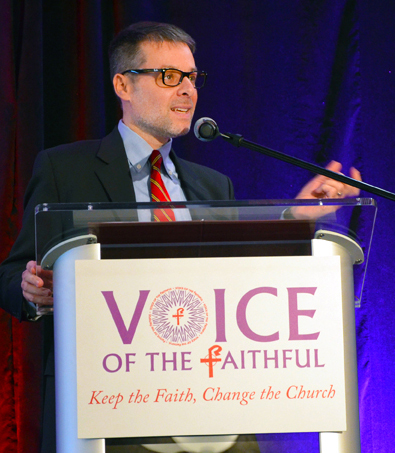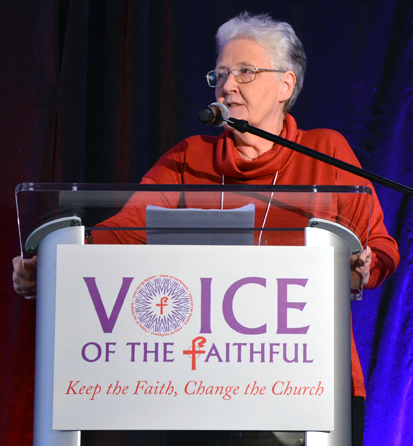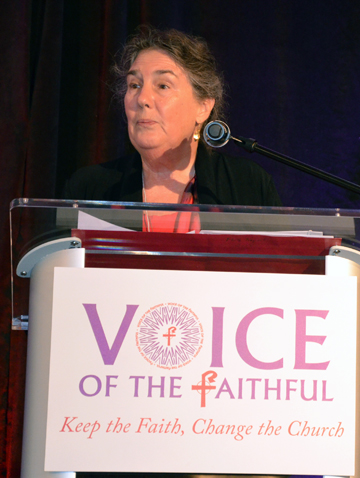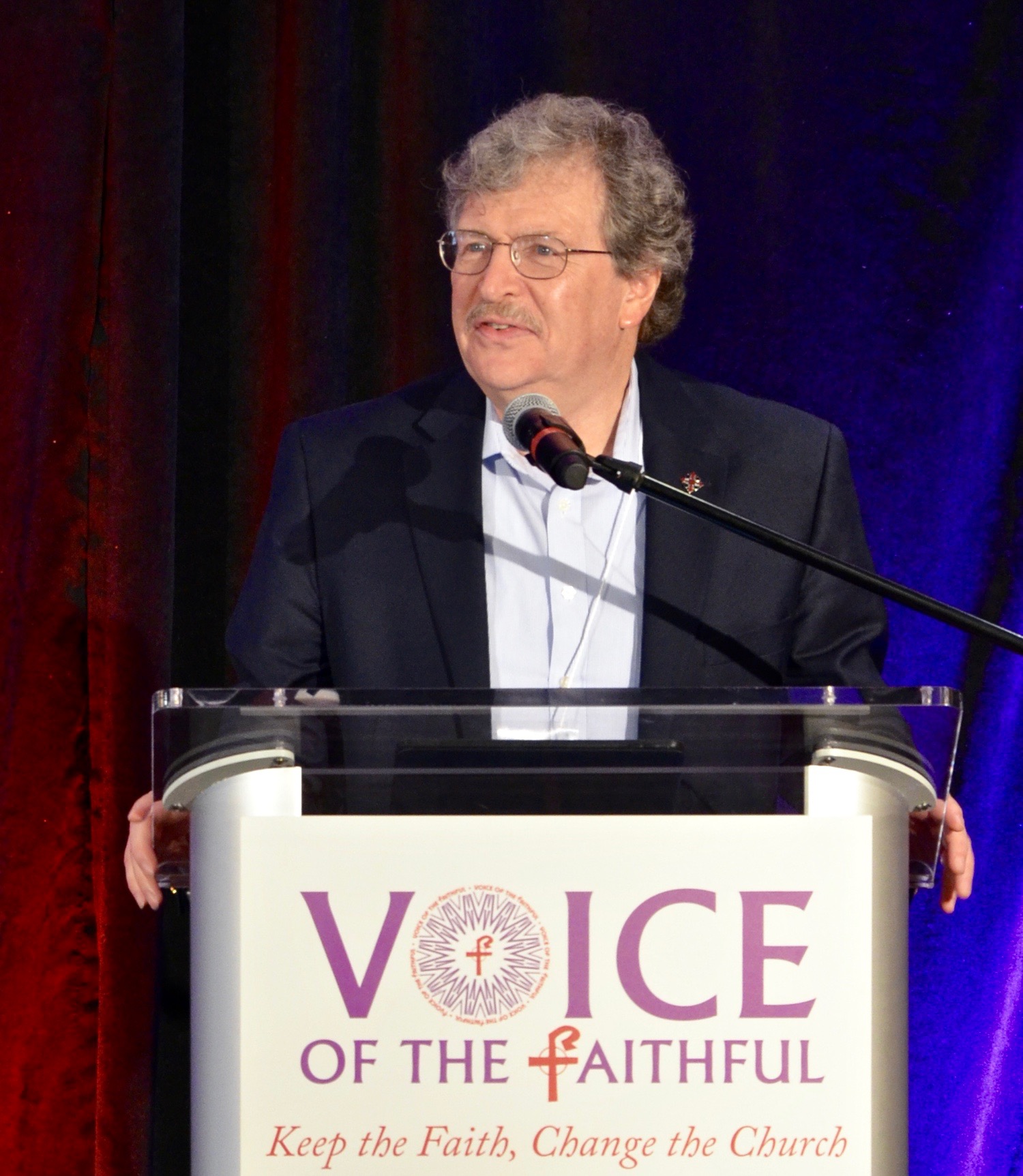Presentations by speakers at our 2018 Conference October 6 in Providence RI provided a framework for examining the problems in the Church today—tracing an arc from the earliest Church through the development of hierarchical dominance to the need for reform, as well as potential opportunities for progress and promise today. Following are highlights and summaries of the speaker’s presentations.
We are grateful to Vincent Rocchio, who filmed and donated all the presentations.
Quick links: Massimo Faggioli Marie Collins Margaret Roylance Bill Clark
Prof. Massimo Faggioli: Legacy and Potential
Click here to see the video in your own browser …
Massimo Fagioli, Ph.D., professor of theology and religious studies at Villanova University in Philadelphia, opened his remarks by noting that when he was invited, about one year ago, he could not have imagined how timely his visit would be. We are in a “new kind of crisis” in the Church, he said.
“This is a vertical crisis, a totally new moment … There is a vacuum of authority.” The crisis also presents opportunities for lay people, but there are limits and problems. One problem, he explained, is the assumption that Vatican II opened doors for laity. While it focused on such potential, however, the “theology of the lay people” from Vatican II was outdated almost as soon as it was expressed.

That theoolgy, Dr. Faggioli said, assumes that laity are an example of human frailty. We are defined in terms of a “lack,” defined canonically as the not ordained, the least important. Ultimately, this theology of the lay people depends on the bishops, the hierarchy, accepting it and acting on it.
Prof. Faggioli then traced the development of the Church’s ruling hierarchy. In the 1st to the mid-2nd century of the Church, it did not exist; there was no distinction between clergy and laity. The differentiation began only in the 3rd and 4th centuries, and it was minimal, based on functions.
Only in the third phase of development, from the 5th century on, did the Church become “empire” and differentiate rigorously between lay people and clerics. It was a way to put some people in charge, to manage the money and the resources. The monk Gratian declared there were two orders of Christians, clergy and laity, and he based that distinction on administration–on who legally could make decisions about the Church and those who could not.
Such distinctions, Prof. Faggioli noted, can only be exacerbated by the more-modern insistence that the Church become more “corporate” because a corporation also focuses on administration.
The Reformation then “hyper-clericalized” the Church, he continued. It became a church built on the episcopate, and that is the church we now see collapsing.
As he described current conditions, Prof. Faggioli identified the problems attendant on trying simply to enact a Vatican II vision of laity as well as the nationalism that has infiltrated Catholicism in the 21st century. The issue of lay people and a theology that encompasses the whole Church is much more complicated than many assume, he said.
“Perhaps we need to return to the Church of the 1st to 3rd centuries,” he suggested, because looking at clergy versus lay people says almost nothing about the what kind of Church we want today.
Catholic laity must reclaim the spaces that are there for us, he concluded, and VOTF has provided an important example of what we need: making spaces.
Marie Collins: Promises and Reality
Click here is you want to watch the video on your browser …
When Marie Collins last spoke at a VOTF assembly, in Hartford in 2015, the Pontifical Commission for the Protection of Minors had just begun its work, Pope Francis had promised complete support, and the appointees–including Marie herself–were highly skilled specialists who could address different aspects of the issue to bring needed reforms worldwide. Marie was one of two clergy abuse survivor members on the Commission.

While speaking about the Commission in 2015 and its structure, Marie also pledged to return to VOTF and discuss the results. Sadly, from that promising beginning, she and the original Commission members met with frustrating setbacks, broken promises, and apparently, in the end, whispered lies among the Curia about them and their work. She resigned last year, citing Curial intransigence as the major reason.
At the conference, Marie reviewed her years on the Commission, the reasons she left, and what needs to be done today and in the future.
Examples of Curia intransigence came from the start, she reported. For example, the Commission never received approval for a budget but had to request every item they needed, one by one, and wait weeks to hear if the request would be approved. Another example: The Vatican would never allow Commission members to obtain IDs that would allow them to enter Vatican City to go to their offices. Instead, each time a member came to Rome, and each time they wished to visit the Commission offices, they had to wait at the gate for some official to grant permission and send someone to accompany them from gate to office.
The Commision meetings were never recorded officially–the members were not assigned a secretary and were told there would be no written records. Worse, when they requested documents on the policies of Curial offices for handling sex-abuse complaints, they were told that such access was forbidden; the policies were private and they were not approved readers–but they were free to go onto the internet and search out the documents there, because some had been placed online. “The Church doesn’t work on logic,” Marie noted at one point.
After providing further examples, Marie said it became obvious that the CDF (Congregation for the Doctrine of the Faith) did not want the Commission to function properly and would circumvent every effort made to move forward. When the CDF refused to implement the Commission recommendations, however, no one ever told the Commission. Later they learned that the CDF refused to act even when directly told to do so by the Pope.
Despite the setbacks and refusals, Marie reported, the Commission continued with the work it set out to do. However, when the original two-year term for this independent commission expired, Pope Francis let it lapse for six months before naming new members. When doing so, he abandoned any appearance of independence by making the newly reconstituted group a part of the very Curia it had tried to reform, removed the remaining effective members, and named as new members only those already owing their allegiance to various institutions within the Church.
Marie believes that the opportunity for true change is now lost. She does not expect much from the new Commission. The one light on the horizon is that civil authorities in country after country are abandoning their reluctance to pursue the crime of clergy sex abuse.
The hierarchy has shown itself to be incapable of responsibility, she concluded. The only hope lies with the people.
Margaret Roylance: VOTF’s 2018 Reporton Diocesan Financial Transparency
Click here to see the video in your own browser.
“We must be sure that never again will our donations be used to cover up crimes against our children,” said Margaret Roylance, VOTF vice president and chair of the Finance Working Group, as she provided the first report on VOTF’s 2018 examination on diocesan financial transparency.

In the past, Margaret explained, Catholics had no idea how much money was being spent on lawyers, non-disclosure agreements, and activities aimed at covering up such crimes. The VOTF report on financial transparency is one tool that faithful Catholics can use to understand what is going on with our dollars.
She then explained the worksheet we use to measure transparency, how the dioceses are scored, and which dioceses did the best and worst in the 2018 report. She also cited those who had made the biggest improvments since 2017, when VOTF published the first transparency report, and those who had regressed since 2017.
Following the conference, VOTF sent copies of the 2018 report to all the U.S. bishops and, after providing sufficient time for their receipt, posted the report online for everyone.
Here are links to the 2018 report and to the handout Margaret provided at the conference:
Appendix C: Alphabetical Listing of Dioceses
Rev. William Clark, S.J.: Connecting as Communityto Meet Today’s Challenges
Click here to see the video in your own browser.
“I am not unaware of the irony that the only cleric on the stage today is billed as an expert on lay leadership,” Fr. Clark noted, as he began his remarks. An Associate Professor in the Department of Religious Studies at the College of the Holy Cross in Worcester MA, Fr. Clark specializes in systematic theology and has a special interest in parish life and issues affecting local church communities.

“But I have been interested for many years in two aspects of our faith that can be great equalizers … Christian spirituality and local community, especially in parish structures,” he continued. Also, “my presentation today doesn’t rely on my priesthood, but on my Baptism …”
Bill went on to describe the deep need to de-clericalize the Church. Organized leadership, spiritual vocations, the sacraments, all can remain in place. But it will be very much better without the exclusive, isolated culture that has grown around the clerical members of the Church over the centuries.
We need, he continued, to be a People of God, to call upon 2,000 years of experience as a living tradition, to respond to challenges from within our Christian tradition. “Jesus is the consummate lay person,” Bill said, so resist the attempt by some clergy to hijack Jesus for clergy-only.
Bill suggested attention to different focus points, rather than cleric/anti-cleric disputes. Focus on Christian witness and on deeds. How do we treat one another? Rely on community more than the isolated individual. Be willing to let go of power, to share leadership.
He recommends the parish itself as the structure that can transform us and return us to the beginnings. Parishes can gather many other communities within it. Ultimately the Church itself is a community of parishes. It must provide space to listen, to communicate, to care.
VOTF fits in with this picture, he concluded, as a community that parishes can and do connect with, with a focus on keeping the faith … and changing the Church—no question the relevance of that.
Our brief summaries above can’t provide the full spectrum of ideas and thoughts heard that day, so we hope you will watch each. When you watch the videos, be sure to hear the Q&A too–lots of good comments there as well.
